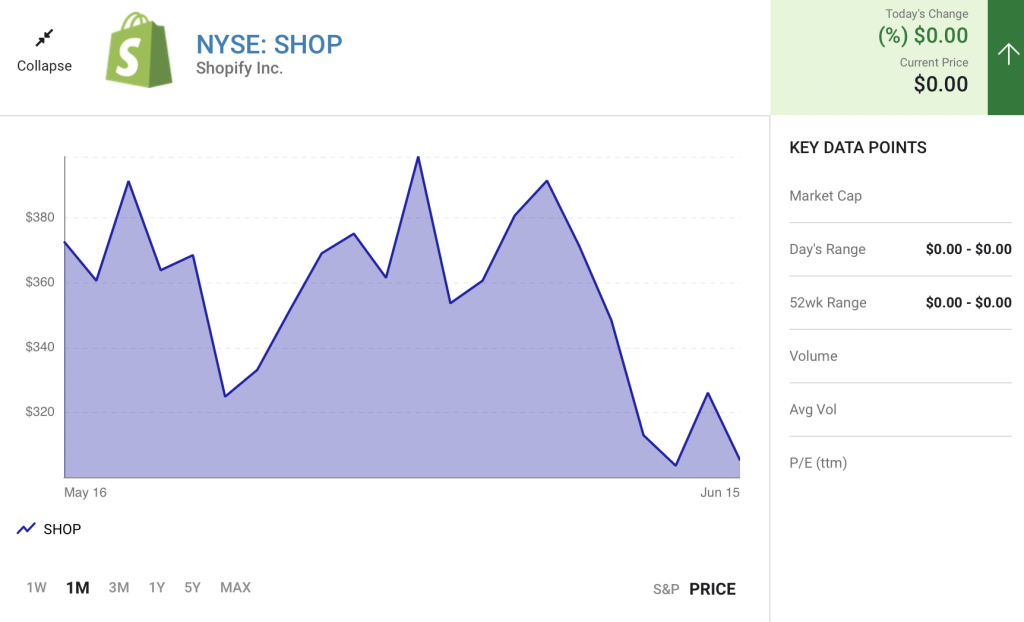Shopify (SHOP) received approval for a 10-for-1 stock split at its annual meeting in early June. Shareholders also voted to issue CEO Tobias Lütke one “founder” share, a measure that effectively gives him 40% voting power for as long as he runs the company. The stock split will go into effect on June 28, and the stock will begin trading on a split-adjusted basis on June 29.
On that day, Shopify shareholders will receive nine additional shares for every one share they already own. But the value of each share will be one-tenth of its pre-split value, meaning a shareholder’s stake in the company does not change. Even so, a lower share price makes the stock accessible to more investors, and that sometimes leads to a post-split pop. With Shopify trading 81% off its high, a rebound would be a welcome relief.
Should shareholders bank on that outcome? Let’s dive in.

Gazing into the Shopify crystal ball
Shopify’s commerce software powers roughly 2.1 million businesses around the world. Unfortunately, many retailers have seen an inflation-fueled drop in demand as consumer spending has shifted to necessities like food and gas, and away from experiences like entertainment and travel.
Shopify shareholders witnessed that trend firsthand when the company delivered somewhat disappointing financial results for the first quarter. Revenue climbed just 22% to $1.2 billion and free cash flow came in at a negative $70 million. But the headwinds may intensify in the coming quarters.
nflation hit a fresh 40-year high in May, according to the U.S. Labor Department, meaning consumer spending will likely remain under pressure for the foreseeable future. To combat rising prices, the Federal Reserve just announced its first 75-basis-point rate hike since 1994. While that should ultimately help cool the overheated economy, it will do so by increasing the cost to borrow money, which will further blunt consumer spending.
Given those headwinds, there is no guarantee that Shopify shareholders will see a post-split bounce. Moreover, if the price does soar, the gains are likely to be short-lived. A stock split has no direct impact on corporate revenue or cash flow, which means splits are unlikely to have a lasting impact on valuation. For that reason, stock splits (and other short-term catalysts) make for a poor investment thesis. That being said, this still looks like a good time for patient investors to buy a few shares of Shopify.
Invest in the stock, not the split
Shopify’s software allows merchants to manage sales across physical and digital channels, including direct-to-consumer (D2C) websites, mobile apps, and online marketplaces. The company also provides value-added services like payment processing, financing, and marketing tools. In short, Shopify offers everything a merchant needs to start, run, and grow a D2C business. That differentiates the company from marketplace operators like Amazon.
D2C models give brands more control over the buyer experience, which makes it easier to build lasting customer relationships. In fact, 64% of consumers will regularly buy directly from brands this year, up 15 percentage points from 2019, according to eMarketer. That trend has been a significant tailwind for Shopify. Its market share in U.S. e-commerce sales hit 10.3% last year, up from 5.9% in 2019, which makes Shopify the second-largest player in the industry (behind Amazon).
To that end, despite disappointing earnings in the first quarter, the company has still delivered solid results over a longer time horizon.

To be clear, Shopify may struggle in the current economic environment. Revenue growth may slow and cash flow could continue to fall. Fortunately, the company has over $7 billion in cash and short-term investments on its balance sheet, so it can weather a downturn.
More importantly, macroeconomic turbulence does not change Shopify’s long-term market opportunity or its value proposition to merchants. E-commerce is taking share from traditional retail, and D2C business models are resonating with businesses and consumers. Shopify helps merchants tap into both of those trends.
In fact, Shopify is the leading e-commerce software vendor in terms of market presence and merchant satisfaction, according to the Spring 2022 G2 Grid report. And with the stock trading at 8.6 times sales, near a five-year low, now looks like a great time to buy a few shares. Just remember, the share price can always fall further, so don’t bank on a stock-split-driven rebound; instead, consider building a position through dollar-cost averaging.





